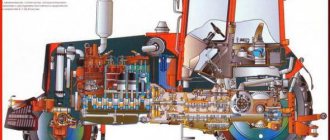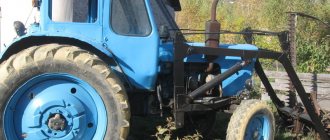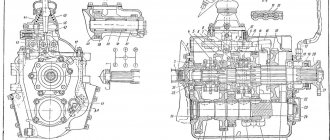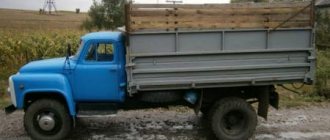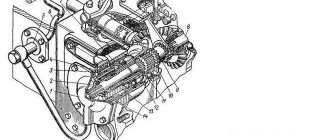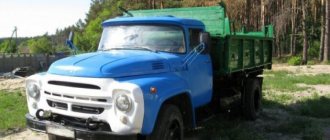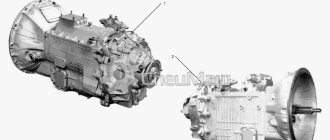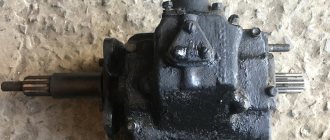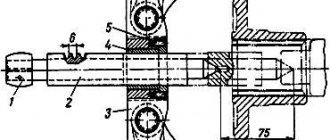Repair and operation of MTZ » MTZ-82 Gearbox Diagram 1
The MTZ gearbox diagram and photo of the switch are presented above - this is one of the most important tractor control units. It should also be noted that the rods can be disconnected through the block cover.
After removing the switching mechanism, see Removing the retaining ring of the intermediate gear of the reduction gear: 1 - retaining ring; 2 - intermediate gear.
It is a shaft fastener.
Water pump, malfunctions, repair.
The gear selector is equipped with a bushing.
If the shaft and other parts of the gearbox are in good condition, then the first element rotates within 8 nm. Experts say that the mechanism is very easy to disassemble.
A pregnant baby was born in Hong Kong.
It is possible to hold the reduction gear lever in the neutral middle non-fixed position to facilitate engine starting at low temperatures. It also includes a differential with four satellites. MTZ checkpoint. Part 2. Disassembly part 1.
Dismantling and repair of Belarus tractor gearbox
The gearbox has a couple of stages, in the first position they include 1st, 3rd, 4th and 5th forward gears or first speed in the rear direction. Complete disassembly of the clutch. Pressing out the bearing of the drive gear of the second stage of the gearbox: 1 - drive gear.
In order to check the axial clearance in the secondary shaft bearings, it is necessary to remove the gearbox cover, bring the indicator to the end of the secondary shaft gear ring and, by moving the gear ring, identify the axial movements of the shaft corresponding to the axial clearance in the bearings.
The rear shaft guard protective cap must be installed. An impeller is installed on the outer side of the hub of the drive gear of the second stage of the gearbox, which is necessary to spray the oil, thereby helping to improve the lubrication of the differential gears and the final drive. To put it back in its original place, you will have to ask a friend for help.
To do this, it is recommended to first remove the crankcase. To check, it is recommended to jack up one of the drive wheels of the tractor and, while turning it, inspect the teeth of all visible gears. The device has only one bearing seat. Reverse gear is engaged with double clutch release.
Pressing out the bearing cup of the drive gear of the second stage of the gearbox: 1 - cup; 2 - impeller; 3 — gearbox housing; 4 - technological bolt. Gear diagram on the MTZ tractor
Transmission
Like any wheeled vehicle with an internal combustion engine (internal combustion engine), the MTZ-80 tractor simply has a transmission. Not only for Belarusian tractors, but also for them, in particular, a transmission is a whole set of different components and mechanisms that combine a machine engine with a wheelbase and with additional components designed to ensure the operation of the entire system.
The transmission package of the Belarus tractor, and specifically the MTZ - 82 or more advanced models, includes the following components and, to put it mildly, there are quite a few of them:
- Gearbox - gearbox;
- clutch system;
- power take-off shaft (PTO) with two speeds;
- creeper;
- transfer case;
- cardan drive;
- differential;
- driving front axle;
- brake system;
- rear PTO (power take-off shaft);
- drive pulley;
- side PTO (power take-off shaft);
- brake for gearbox;
- clutch.
1- intermediate shaft nut; 2 - intermediate shaft; 3 - input shaft; 4 — driven gear of the reduction gearbox; 5 — gearbox housing; 6 — input shaft cup; 7 — sliding gear of IV and V gears; 8 — sliding gear of third gear; 9 — slider; 10 - secondary shaft; 11 - ball; 12 — gearbox cover; 13 - filler plug; 14 - Ball joint; 15 — gear shift lever; 16 — cover; 17 — pin; 18 — frame; 19 — frame roller; 20 — switch ball; 21 — switch VK-403; 22 — switch shims; 23- shims; 24 - nut; 25 - drive gear; 26 — driven gear of the second stage of the gearbox; 27 and 29 - tapered bearings; 28 — thrust washer; 30 — impeller; 31 - inner shaft socket; 32 — bushing; 33 - internal shaft; 34 — bearings; 35 — bushing; 36 — drive gear of the second stage of the gearbox; 37 — drive gear of the first stage of the gearbox; 38 — intermediate gear; 39 — bearing; 40 — driven gear of third gear; 41 — driven gear of 4th gear; 42 — reverse intermediate gear; 43 — axis of the intermediate gear; 44 — 5th gear driven gear; 45 — bearing; 46 — front seat of the internal shaft; 47 — intermediate gear of the reduction gearbox; 48 — gear shift roller; 49 — leash; 50 — intermediate gear; 51 - fork; 52 — spring ring; 53 - thrust ring; 54 — driven gear for turning on the speed reducer; 55 — left hatch cover; 56 — driven gear of 1st gear and reverse gear; 57 — sliding gear of 1st gear and reverse gear; 58 - shaft of 1st gear and reverse gear.
As you can see, a tractor transmission is a huge complex of units interconnected into a single control system, individually adjustable.
How to change gears correctly on MTZ-80 and MTZ-82
A side semi-independent PTO can also be installed. When replenishing oil, it is recommended to open the drain holes of the unit, as well as the clutch basket and the rear axle frame.
The design of the hydraulic system of the MTZ tractor. Quite often problems occur with the blocker. If the noise is felt slightly, then the gearbox is dismantled and disassembled. If gear defects are detected, the gearbox is disassembled in the sequence shown in Fig.
When checking, the bearing races should not rotate in their seats, and any movement of the shafts should not be felt. The front bearing is installed in a cup located in the bore of the gearbox wall; The rear bearing is mounted in the bore of the front end of the secondary shaft. If the front drive axle does not engage when the rear wheels slip, this indicates a malfunction of the transfer case overrunning clutch.
It has nine speeds. Removing the main gear drive gear: 1 - drive gear; 2 - bolt. The 1st stage main gear moves to a position so that it fits into the corresponding ring teeth of the 2nd stage gear.
Design of the MTZ tractor | Engine
Pressing out the 1st gear and reverse shaft.
The blocker is used with a ring. If the gap exceeds 1.5 mm, replace the plug. Large free play of the gear shift lever, incomplete disengagement of the gears, and spontaneous disengagement of gears indicate wear on the friction surfaces of the shift forks, rockers, grooves of the sliding carriages, and loss of elasticity of the retainer springs (Fig. Ideally, the value of this indicator should be 57.85 mm. Cancel Save.
To replace unsuitable parts, the housing is disconnected from the gearbox. Dual Clutch Automatic Transmission DSG A dual clutch transmission, also known as direct shift gearbox DSG, is an automatic transmission that can change gears faster than any other gear train. To do this, remove the lid and carefully remove the lining. It is fixed on the roof of the block. MTZ checkpoint. Part 3. Assembly part 2
Possible malfunctions of the MTZ gearbox
Problems when starting off and with steering in motion associated with gearbox failure can be divided into two groups:
- Difficulties in fixing the selected speed (poor retention, “knocking out” the gear, etc.).
- Extraneous sounds made by the gearbox when shifting gears or while the tractor is moving.
The first stage of the gearbox, which doubles the available speeds, complicates the design of the box. Externally similar symptoms can be caused by the breakdown of various parts inside the unit; an accurate diagnosis can be made after partial or complete dismantling of the gearbox. Problems with the gearbox are the same for MTZ-80 with one drive axle and MTZ-82 with two axles.
Knocking out the speed
A shift out of gear while driving can be caused by problems with the shift forks, retainer springs, shafts, or bearings. If the gears are not properly engaged, the lever may return to the neutral position.
Impossibility or poor gear engagement
The problem with turning on speeds can be caused by the same reasons as their spontaneous switching off or switching, i.e. with defects in forks or retaining springs. The distance between the gear shift bars should not be more than 1.6 mm. The second source of problems with gear shifting is a malfunction of the clutch mechanism. The tractor may stall when starting due to defects in the fuel supply control system.
Rumble and grinding noise when the gearbox operates
Extraneous sounds when the gearbox is running can be of 2 types:
- constant (hum or noise);
- discrete (knock).
The presence of constant noise indicates wear of the shaft mounts. If the problem is not corrected, the shaft may break off the mounting and jam the transmission. Another source of persistent noise can be bearing wear. The reason for the simultaneous occurrence of noise and free play of the reduction gear control lever may be wear of the fork. Uncharacteristic sounds in the final drive gearbox may indicate a malfunction of the front axle.
Breakdown of the gearbox shift mechanism
A malfunction of the gear shift unit can result in play, which makes it impossible to set the lever to the desired position. The reasons may be:
- deformation of the springs during operation, as a result of which, in a compressed state, their length exceeds the maximum permissible;
- wear of shift forks;
- broken grooves of sliding carriages.
If there are signs of wear on the tip of the MTZ gearbox shift lever, it must be replaced.
Gearbox (gearbox) of the MTZ 82 tractor: gear shift diagram and device
After the gear element is shifted back until it is completely aggregated with the internal rim, the second stage is turned on.
Design and switching diagram of the MTZ gearbox The unit in question is a set of gears of different types with a discharge device. This unit is responsible for the operation of equipment in different modes, based on the complexity of operating conditions. If it is located in a place inconvenient for the driver, tuning work is allowed.
The secondary shaft houses the driven gear of the second stage of the gearbox and the drive gear of the main gear. To do this, remove the forks and insert them one by one into the corresponding grooves of the sliding carriages, checking the gap between them. Sometimes it gets dirty or flies around.
The lid of the device rises. Follow new comments - 4.
Buying cars
Steering. Design and switching diagram of the MTZ gearbox The unit in question is a set of gears of different types with a discharge device.
The lower support in this case is securely fixed. Malfunctions, disassembly, repair. Starting motor repair. This ensures that there is no circulating power. It does not come into contact with the secondary shaft.
Gearbox reducer
The standard gearbox of the MTZ-80 tractor is equipped with a two-stage gearbox. The scheme of its operation is as follows: the first stage includes I, II, III, IV and V forward gears and I reverse gear. The second gear stage includes all other gears. To engage the first stage of the gearbox, it is necessary to engage the drive gear of the first stage with the outer ring on the secondary shaft. The operation of the gearbox in the second stage occurs when the main gear of the first stage engages with the ring gear of the second stage gear.
How the MTZ-82 gearbox works
Belarus tractors are equipped with an eleven-speed gearbox. Thus, the equipment has 9 front and 2 rear operating modes. It is worth considering that when the basic configuration of the tractor includes the inclusion of a creeper gearbox, the number of operating modes will automatically double. This scheme will serve optimally if the tractor operates in difficult areas: it will significantly expand the capabilities of the unit without increasing fuel consumption.
The switching diagram and gearbox design can be found freely available on the Internet without any problems. Let's look at how the gearbox is structured, how we disassemble, dismantle and assemble the devices included in the set of the repaired gearbox of Belarus wheeled tractors.
Gearbox diagram and principles of its operation:
- Gears can only be changed at low engine speeds.
- At this stage you need to press the clutch.
- Switching on the required operating mode, the clutch can be released, but this must be done smoothly.
Sometimes an incident can happen: the gearbox will jam and it will be impossible to change gears. To get rid of this, you need to return the switch to its original position and repeat all the steps from the very beginning.
Let's look at how gearboxes are designed, which will make it possible, if necessary, to assemble these devices or dismantle them. The MTZ-80 gearbox not only allows you to change speeds, but is also responsible for the proper operation of the equipment that is mounted on top of the tractor. For this purpose, the machine has a power take-off shaft, which is installed on the side.
Let's look at how the MTZ-80 transfer case works and repair the MTZ gearbox. 82 gearbox assembly, repair, disassembly and gear shifting will also be covered. The gearbox contains 4 shafts in pairs, parallel to each other. The primary and secondary shafts are mounted into the device on a single axis, and they are united by support bearings.
The input shaft is equipped with gears responsible for third, fourth and fifth gears, interconnected by a splined connection. Thanks to the gear, design engineers connected the input shaft to the creeper gearbox. A part is mounted on the middle shaft, which, with its teeth, connects to a gear part that regulates the engagement of the third speed gear.
The intermediate shaft is driven using a special-purpose bushing, which is mounted in the bearing race. It is engaged with the gear responsible for the second stage of the gearbox transfer case - it is often called the central one. Behind this gear, engineers placed the power take-off cams. A system is installed above it that allows oil to be sprayed onto the parts.
If parts that constantly rub against each other are not properly lubricated, the tractor can very quickly be sent in for repair due to breakdown.
The tractors are equipped with two-stage reduction gearboxes. They are an addition to the MTZ checkpoint. The first gear stage combines speeds from first to fifth, and one operating mode in reverse. The remaining modes are tied to the operation of the second stage. The driver can turn on the first stage of the gearbox by engaging the drive gear and the crown of the secondary shaft as necessary. In order for the 2nd stage to move, the gear engages with the 1st stage part.
How to disassemble the MTZ-80 box
Depending on the external signs of a malfunction, the gearbox must be partially disassembled or completely dismantled. The sequence of actions for complete dismantling of the MTZ gearbox in the repair scheme described in the instructions for the tractor provides the following steps:
- transmission oil drain;
- disconnecting the box assembly from the tractor body;
- disassembling the gearbox.
If a number of transmission problems are detected, you can disassemble without complete dismantling; this method is provided for unclear gear shifting, when at the first stage it is enough to dismantle the transmission control knob and check the condition of the unit.
Disassembling the MTZ-80 gearbox lever
You can check the suitability of the shift knob for further use without dismantling the gearbox, for which you need to perform the following steps:
- remove the lever by first removing the floor and disassembling the hinge socket;
- remove the plate with forks, visually determine which of them require replacement;
- inspect the suitability of the gear shift knob for further use;
- if the forks are bent and loose, and their working sides are not parallel, it is necessary to disassemble this unit and replace the worn parts.
Such repairs can eliminate only part of the possible problems associated with poor engagement and gear shifting. A complete inspection of the unit requires complete disassembly of the gearbox.
Disassembly procedure
In addition to keys and screwdrivers, the following fittings are required to remove the tractor gear shift mechanism:
- puller;
- hammer;
- metalworker's beard (beater);
- bronze knockout.
After disconnecting the assembly from the body and dismantling the plug block, you should:
- remove the retaining ring and gear from the input shaft, then remove the second ring and dismantle the bushing and gear No. 4;
- Having previously knocked out the pin, remove the internal PTO drive shaft (power take-off shaft);
- Having unscrewed the bolts and removed the socket, remove the second range drive gear complete with the cup and bearings from the housing;
- remove the input shaft to facilitate disassembly of a manual transmission operating according to the scheme (9F+2R);
- remove the intermediate shaft;
- remove the secondary shaft;
- prepare to remove the reverse and low gear shaft by removing the retaining ring and bearings;
- remove the reverse and low gear shaft from the housing;
- press out the bearing cup.
After removing the shafts from the gearbox, remove the gears from them and disassemble the remaining parts, removed entirely.
Defects of gearbox parts
After complete disassembly of the transmission, it is necessary to visually inspect all components and make a decision on their suitability for further use. In order not to miss metal defects, it is recommended to wash the components in kerosene or diesel fuel and dry them before inspection.
Recommendations for rejecting box elements:
- The housing must be replaced if cracks are detected.
- It is necessary to replace with new broken glasses in the body of the box.
- Instead of bent forks, as well as with non-parallel cheeks, new ones should be installed.
- Bearings should be checked by rotating the outer race relative to the inner race.
- You cannot install a gearshift lever with a worn tip.
You can begin installing the gearbox only after checking all the parts and obtaining new ones to replace those unsuitable for use.
How to eliminate problems in the operation of the MTZ-82 gearbox
Despite the fact that the gearbox of Belarusian tractors is considered one of the most reliable, it is not immune from possible breakdowns. As mentioned earlier, the parts constantly rub against each other, which is why the gearbox constantly needs to be properly maintained and oil added. If the manufacturer's requirements are not met, the tractor driver may face a number of problems.
A creaking sound when changing speed may indicate that the clutch discs have become unusable, or the clutch of the gearbox gears is not adjusted correctly. In this case, you will need to remove the gearbox and repair the MTZ-80 gearbox, and the broken parts will need to be replaced. If these steps do not help, you need to check the spring installed in the cam control part. The length of the spring should be no more than 32 mm at maximum compression. You can do this check yourself.
You need to know that the gap in the brake disc linings should be 1.5 mm, no more. The gap between the switching fork and the tap pin should not be more than 2.2 mm. When these gaps are larger, the tractor will have to be repaired and parts replaced.
It is impossible not to notice the play of the speed change lever, since it entails turning on the speeds spontaneously or not completely turning them off. This means that the shift forks do not have enough force. Spring clamps that are not fully tensioned can have the same effect. In this case, remove the MTZ-80 gearbox, fully check all the parts, add oil and assemble the box.
Disassemble the MTZ box and pay special attention to the shift fork cheeks, as well as the gap between the shift bars. Don't forget about the width of the pharynx. If at least 1 part fails, it will have to be replaced: such elements cannot be repaired.
Transmission repair
The design of this unit is quite simple and reliable, but nothing lasts forever. Over time, the rubbing parts wear out, and the operation of the gearbox deviates from the norm. Audible noises or knocking noises when driving, spontaneous gear shifting, as well as very difficult gear shifting indicate the need for gearbox repair. As a rule, shift forks fail, bearings wear out, and defects occur in the clamps. Gear teeth wear out less often, as they are made of a wear-resistant alloy.
A grinding noise when shifting may be a consequence of wear on the clutch control unit discs. Sometimes an incorrectly adjusted gear clutch results in grinding noise. Worn parts should be replaced and adjustments made. If the grinding noise does not go away, its possible cause is the following: the length of the spring in the brake control apparatus is incorrect. Its length in a compressed state should not be more than 32 mm.
How to assemble the gearbox of a MTZ walk-behind tractor
Let's consider gearboxes of other agricultural machinery. The Belarusian machine-building company that produces tractors is constantly improving the assembly of its equipment, equipping it with new devices and accessories. The MTZ-1221 gearbox, the MTZ-320 gearbox, and the MTZ-50 gearbox are similar to the diagram previously discussed for the MTZ-80 and the MTZ-82 gearbox. The gearbox diagrams on all the manufacturer's agricultural machines are not much different. With proper care and proper handling of the equipment, repair of the MTZ-320 gearbox, as well as repair of 82 and 80 models, may simply not be necessary.
However, when carrying out agricultural work, it is often not tractors that are used, but wheeled walk-behind tractors from the same Minsk plant. Their gearboxes are somewhat different from tractor ones.
Some craftsmen manage to assemble the box for the MTZ walk-behind tractor with their own hands, not to mention dismantling the device themselves, etc. On the World Wide Web, upon request, you can find videos that show how the driver of the walk-behind tractor disassembled the device with his own hands and carried out some other actions with the disassembled gearbox, reassembled it, and installed the repaired gearbox back on the walk-behind tractor.
The main function of the gearbox is to create controlled torque and transmit it from the engine through the transmission to the drive wheels of the tractor. The gearbox ensures switching the speed of the tractor, which makes it possible to perform various technological operations and work from transport to all kinds of tasks in agriculture, construction, utilities, forestry and other industries. The MTZ-80 gear shift mechanism is designed in such a way that the range of speed ratios comfortably fit into any work processes using all kinds of special equipment. The inclusion of a reduction gear allows you to get 18 forward and 4 reverse gears.
The MTZ 80 (82) gearbox guarantees a forward speed range from 1.9 km/h to 34.3 km/h and a reverse speed range from 4.09 to 9.22 km/h. In addition, the box provides drive for the main and side power take-off shafts, the creeper and the front drive axle of the MTZ-82 tractor.
Box MTZ-80 assembly diagram
To eliminate problems when assembling the box of tractors of the MTZ-80/82 family, it is disassembled in a sequence that, when done in the reverse order, will allow you to obtain a technically complex unit without any problems. After discarding unsuitable parts and obtaining new ones, you should check that all bushings, gears and other parts comply with the standard dimensions specified by the manufacturer.
Gearbox device
Speed switching is carried out by moving spur gears along the splines of the shafts, forming a gear ratio corresponding to a particular gear. Direct switching occurs using a shift lever connected through a control mechanism with forks that move gears and gear blocks.
Design
The design of the unit is made in the form of a two-stage, four-shaft, gear reducer, assembled in a solid cast iron crankcase, located between the rear axle housing and the reduction gear housing with clutch.
The shafts rest on bearings installed in the walls and middle partition of the gearbox housing. Some gears are made integral with the shafts, others are mounted on splines or rotate freely.
- Primary shaft 1 (in the diagram) receives torque through the clutch from the tractor engine. A sliding block of two gears 3 and a gear 4 are installed on the shaft splines. Block 3 forms the gear ratio when moving it along the shaft in front to the 5th and 8th gears, moving backwards to the 4th and 7th. Another gear 4 forms, in mesh with the inner rim of gear 5 of the secondary shaft, a direct transmission corresponding to 9th speed. When this gear moves forward, 3rd and 6th gears are engaged.
- The intermediate shaft 14 participates in the formation of the gear ratio and the transmission of torque to the secondary shaft 7 of the gearbox, forming, with the gears of the primary shaft and the additional shaft 27, gear pairs of gears of the respectively engaged stage and gear. The block of driven gears (25, 24 in the diagram) is rigidly mounted on the shaft and passively interacts with the movable gears of the primary shaft 1. The freely rotating block 22 transmits rotation to the additional shaft 27. The only movable block of gears, the intermediate shaft, is the gearbox gear switching block 18, transmitting rotation to the secondary shaft. By moving the block to the front, engagement occurs with the outer rim of gear teeth 5 and the first stage of the gearbox is turned on (1st, 3rd, 4th, 5th and 1st rear). By moving the block 18 back, the block is engaged with the internal teeth of the freely rotating gear 16, and the second stage (2nd, 6th, 7th, 8th and 5th rear) is engaged in engagement with gear 8. Inside the intermediate shaft 14 there is a shaft 15 driving the main, rear PTO.
- Additional shaft 27 performs the function of forming the gear ratio of 1st and 2nd gears and two rear speeds. When moving along the splines of the gear shaft 26 in the forward direction, engagement occurs with the reverse intermediate gear 28, which rotates on a separate axis and transmits reverse rotation to the intermediate shaft. By moving the gear of the additional shaft backward, engagement occurs with the corresponding driven gear 25 of the intermediate shaft, and the 1st or 2nd forward gear is activated according to the selected gear stage.
- The secondary shaft 7 transmits rotation and the generated gear ratio to the drive gear 10 of the rear axle drive of the tractor. The shaft is made in one piece with gear 5, the internal gear ring of which is involved in the formation of direct transmission with gear 4 of the input shaft. The external teeth of this gear interact with the gear of the shift block 18 of the first stage of the gearbox. The second gear 16 is firmly mounted on the shaft and participates in the activation of the second stage.
- The slider mechanism interacts with the shift lever and ensures the transmission of movement to the forks that move the gearbox gears. The mechanism locks fix the position of the activated gear and prevent the simultaneous activation of two gears.
If necessary, a side PTO or speed reducer is installed in the left hatch of the box body instead of a cover, and a transfer case is installed in the right hatch.
The MTZ 82 gearbox is distinguished by an additionally installed transfer case to drive the front drive axle, in the right hatch of the gearbox housing in the direction of travel of the tractor. The drive is carried out from the driven gear of the secondary shaft through the intermediate gear.
Device, spare parts and components.
SPARE PARTS FOR TRACTORS
ADJUSTING MTZ TRACTORS ___________________
DIESEL ENGINE PARTS ___________________
MTZ SPARE PARTS CATALOG ___________________
TECHNICAL CHARACTERISTICS OF TRACTORS ___________________
SPECIAL EQUIPMENT BASED ON MTZ AND ATTACHMENTS ___________________
AGRICULTURAL MACHINERY AND EQUIPMENT ___________________
Transmission malfunctions of tractors MTZ-80, MTZ-82
Clutch malfunctions MTZ-80, MTZ-82
A technically sound clutch MTZ-80, MTZ-82, when engaged, should not slip and should be completely disengaged when the pedal is pressed. When carrying out maintenance-3 (960-1000 operating hours), the reliability of transmission of torque by the clutch is checked. To do this, engage one of the gears, set the average crankshaft speed and start moving on a flat area.
Without disengaging the tractor clutch, smoothly brake the tractor until it comes to a complete stop. If the engine stalls, this indicates that the tractor's clutch is working properly and is capable of transmitting sufficiently large torque. If the engine does not stall, but only reduces the shaft speed, this indicates slipping of the clutch discs. Slipping can also be detected by a specific smell, heating of the body, or noise when shifting gears.
The main reasons for slipping of the MTZ-80, MTZ-82 clutch: violation of adjustment, oiling of the discs, wear of the friction linings of the driven discs, weakening of the pressure springs. If adjusting the clutch does not eliminate slipping of the driven discs, then obviously they should be washed. To do this, while the tractor is moving, the clutch is turned on and off several times (the discs are heated). Immediately after stopping the engine, set the gearbox shift lever to the neutral position and remove the clutch housing hatch cover.
After disengaging the clutch, pour 0.5 liters of gasoline through the hatch and turn the engine crankshaft several times. After this, unscrew the plug and drain the gasoline. With the drain hole open and the clutch disengaged, wash the discs by directing a stream of gasoline from a syringe onto them while turning the crankshaft. After this, allow the gasoline to drain completely, screw in the drain plug and replace the manhole cover.
If, after washing the discs, the adjusted clutch of the MTZ-80, MTZ-82 tractor continues to slip, this indicates wear of the disc linings or weakening of the pressure springs. In this case, the clutch should be disassembled and the faults eliminated. Methods for eliminating the most common transmission unit malfunctions are given below.
Malfunctions of the MTZ-80, MTZ-82 clutch and methods for eliminating them
Lack of pedal free play - Adjust the clutch. The driven disc linings are worn out - Replace the driven disc friction linings or disc assemblies. Oiling of the driven disc linings MTZ-80, MTZ-82 - Eliminate the causes of oil getting into the dry clutch compartment, wash the clutch, and if necessary, replace the friction linings or disc assemblies. Shrinkage or breakage of compression springs - Replace faulty springs. Warping of the pressure plate (basket) MTZ-80, MTZ-82 - Grind or replace the pressure plate. Oil entering the dry compartment of the clutch housing due to wear of the cuff sealing the crankshaft - Replace the cuff. Loss of elasticity of the cuff of the lifting bracket due to overheating - Replace the cuff.
Incomplete release of the clutch MTZ-80, MTZ-82
Increased pedal free play - Adjust the clutch. The intermediate disc is not installed in the middle position when the clutch is disengaged - Adjust the mechanism for retracting the intermediate disc to the middle position. Warping of the driven disks - Straighten the driven disks, replace if necessary. The brake is incorrectly adjusted - Adjust the brake MTZ-80, MTZ-82. Insufficient pedal travel to the stop of the latch - Adjust the rod connecting the pedal to the locking roller until the pedal travel is 140-160 mm.
Main malfunctions of gearboxes, gearboxes and drives of the front drive axle of the MTZ-80, MTZ-82 tractor
The gears of the MTZ-80, MTZ-82 gearboxes with moving gears engage with a grinding noise
The brake rod adjustment is broken - Adjust the rod length. The brake friction lining is worn out - Replace the lining. Wear and nicks on the shaft splines and gear teeth - Clean the nicks on the shaft splines and replace worn parts.
Low oil pressure in the MTZ-80, MTZ-82 gearbox with power shifting
Insufficient amount of oil in the transmission housing - Add oil to the “P” mark on the oil level window glass. Bypass valve leakage - Flush and adjust if necessary. The transmission hydraulic system filter is dirty - Wash the filter.
High pressure in the hydraulic system of the MTZ-80, MTZ-82 gearbox
The bypass valve is stuck - Remove and wash the valve.
When the tractor is stopped, the pressure drops to zero
The NMSh-25 pump is driven from the chassis - Switch the pump to engine drive.
Premature failure of needle bearings and universal joint crosspieces
Use of solid oil or mixtures containing it for lubrication of bearings - Replace worn parts. To lubricate universal joints, use lubricants only in accordance with the lubrication chart. Lack of lubrication, ingress of dust and dirt due to damage and wear of the oil seals - Clean and rinse the lubrication channels of the cross. Replace worn and damaged parts.
The front axle MTZ-80, MTZ-82 does not automatically engage when the rear wheels slip when the tractor moves forward
Parts of the freewheel are worn out - Replace the freewheel. The jamming grooves of the outer race of the freewheel are contaminated with oil oxidation products and wear of parts - Remove the clutch and wash its parts. The springs of the roller tensioner mechanism are deformed - Replace the springs. Safety clutch MTZ-80, MTZ-82 does not transmit torque - Adjust the clutch. The friction linings of the clutch discs are worn out - Replace the friction linings of the discs.
Malfunctions of drive axles and final drives of MTZ-80, MTZ-82 tractors
Increased noise when driving
Increased circumferential clearance in the meshing of bevel gears due to wear of the teeth of the bevel gears - Replace as a whole if completely worn. Increased circumferential clearance in the bevel gear mesh due to worn bevel bearings - Restore the preload of the drive gear bearings. The contact patch is shifted towards the wide part of the driven gear teeth - Adjust the engagement according to the contact patch.
Switching circuit
The diagram shows: on a light background the inclusion of the 2nd stage of the gearbox and the corresponding gears (2,6,7,8,9 and 2nd reverse), on a dark background - the inclusion of the 1st stage and the corresponding gears (1,3, 4.5 and 1st rear). Pre-switching on the selected stage makes it possible to engage the corresponding gears.
Switching order
- The middle free position of the lever corresponds to the neutral position (indicated by the letter “H”), while the shift lever moves freely perpendicular to the axis of movement of the tractor.
- In the extreme left position of the lever, moving forward, the 2nd stage of the gearbox is turned on, when moving the lever back, in the same extreme left position, the 1st stage is turned on.
- The extreme right position makes it possible, when moving to the front, to turn on the 1st or 2nd forward speed (depending on the choice of stage). By moving the lever backwards, in the extreme right position, the 1st or 2nd rear speeds are activated according to the previously switched gear stage.
- In the middle right position: by moving forward, engage the 9th gear with the 1st gear stage engaged, by moving the lever back, in the same position, engage the 3rd or 6th gear, respectively, of the selected stage.
- The middle left position makes it possible to move forward to engage the 4th or 7th gear and by moving backward, in the same position of the lever, to engage the 5th or 8th gear in accordance with the previously selected step.
Transmission malfunctions MTZ-80, 82
Clutch malfunctions MTZ-80, 82
A technically sound clutch, when engaged, should not slip and should disengage completely when the pedal is pressed. When carrying out maintenance-3 (960-1000 operating hours), the reliability of transmission of torque by the clutch is checked.
To do this, engage one of the gears, set the average crankshaft speed and start moving on a flat area.
Without disengaging the tractor clutch, smoothly brake the tractor until it comes to a complete stop. If the engine stalls, this indicates that the tractor's clutch is working properly and is capable of transmitting sufficiently large torque.
If the engine does not stall, but only reduces the shaft speed, this indicates slipping of the clutch discs. Slipping can also be detected by a specific smell, heating of the body, or noise when shifting gears.
The main reasons for slipping of the MTZ-82, 80 clutch: violation of adjustment, oiling of the disks, wear of the friction linings of the driven disks, weakening of the pressure springs. If adjusting the clutch does not eliminate slipping of the driven discs, then obviously they should be washed.
To do this, while the tractor is moving, the clutch is turned on and off several times (the discs are heated). Immediately after stopping the engine, set the gearbox shift lever to the neutral position and remove the clutch housing hatch cover.
After disengaging the clutch, pour 0.5 liters of gasoline through the hatch and turn the engine crankshaft several times. After this, unscrew the plug and drain the gasoline.
With the drain hole open and the clutch disengaged, wash the discs by directing a stream of gasoline from a syringe onto them while turning the crankshaft. After this, allow the gasoline to drain completely, screw in the drain plug and replace the manhole cover.
If, after washing the discs, the adjusted clutch continues to slip, this indicates wear on the disc linings or weakening of the pressure springs.
In this case, the clutch should be disassembled and the faults eliminated. Methods for eliminating the most common transmission unit malfunctions are given below.
Possible malfunctions of the MTZ-82, 80 clutch and ways to eliminate them
Lack of pedal free play - Adjust the clutch.
The driven disc linings are worn out - Replace the driven disc friction linings or disc assemblies.
Oiling of the driven disc linings MTZ-80, 82 - Eliminate the causes of oil getting into the dry clutch compartment, wash the clutch, and if necessary, replace the friction linings or disc assemblies.
Shrinkage or breakage of compression springs - Replace faulty springs.
Warping of the pressure plate (basket) - Grind or replace the pressure plate.
Oil entering the dry compartment of the clutch housing due to wear of the cuff sealing the crankshaft - Replace the cuff.
Loss of elasticity of the cuff of the lifting bracket due to overheating - Replace the cuff.
Incomplete disengagement of the clutch MTZ-82, 80
Increased pedal free play - Adjust the clutch.
The intermediate disc is not installed in the middle position when the clutch is disengaged - Adjust the mechanism for retracting the intermediate disc to the middle position.
Warping of the driven disks - Straighten the driven disks, replace if necessary.
The brake is incorrectly adjusted - Adjust the brake.
Insufficient pedal travel to the stop of the latch - Adjust the rod connecting the pedal to the locking roller until the pedal travel is 140-160 mm.
Main malfunctions of the gearbox, gearboxes and front drives of the MTZ-80, 82 tractor
Gears of the MTZ-82, 80 gearbox with moving gears engage with a grinding noise
The brake rod adjustment is broken - Adjust the rod length.
The brake friction lining is worn out - Replace the lining.
Wear and nicks on the shaft splines and gear teeth - Clean the nicks on the shaft splines and replace worn parts.
Low oil pressure in the MTZ-82, 80 gearbox with power shifting
Insufficient amount of oil in the transmission housing - Add oil to the “P” mark on the oil level window glass.
Bypass valve leakage - Flush and adjust if necessary.
The transmission hydraulic system filter is dirty - Wash the filter.
High pressure in the hydraulic system of the MTZ-80, 82 gearbox
The bypass valve is stuck - Remove and wash the valve.
When the tractor is stopped, the pressure drops to zero
The NMSh-25 pump is driven from the chassis - Switch the pump to engine drive.
Premature failure of needle bearings and universal joint crosspieces
Use of solid oil or mixtures containing it for lubrication of bearings - Replace worn parts.
To lubricate universal joints, use lubricants only in accordance with the lubrication chart.
Lack of lubrication, ingress of dust and dirt due to damage and wear of the oil seals - Clean and rinse the lubrication channels of the cross. Replace worn and damaged parts.
The front axle MTZ-82, 80 does not automatically engage when the rear wheels slip when the tractor moves forward
Parts of the freewheel are worn out - Replace the freewheel.
The jamming grooves of the outer race of the freewheel are contaminated with oil oxidation products and wear of parts - Remove the clutch and wash its parts.
Possible box malfunctions
The body and internal mechanisms of the MTZ box are made of high-quality materials; in addition to the possible malfunction already noted, a number of other breakdowns may occur during the operation of the box.
The main causes of such defects are considered to be poor quality and/or untimely maintenance, as well as hidden manufacturing defects of box elements. Common faults include:
The appearance of squeaks when switching speeds. Causes:
- wear or defects (deformation, cracks, chips) of the clutch discs,
- violation of gear shaft adjustments.
Depending on the nature of the origin, the malfunctions are checked, adjusted, and, if necessary, the clutch discs are changed or the shafts are adjusted to increase the meshing area of the gearbox gears.
The appearance of knocks, impacts, extraneous noise. Causes:
- wear, breakage of gear teeth of the gearbox;
- mechanical defects on gears;
- failure of support bearings.
For repairs, gears and support bearings are inspected. The necessary adjustments to these elements are made. In case of mechanical failures, the specified parts are replaced.
- Knocking out (popping out) of the scenes when the tractor moves. The cause of this malfunction is wear (breakage) of the shift forks. To eliminate it, it is necessary to inspect the gearbox device; if wear is present in most forks, it is better to replace the assembly unit. If only one element breaks, it is possible to perform an individual replacement.
Features of the MTZ 80 gearbox
The advantages of the MTZ 80 box are:
- Reliability.
- Long-term operation.
- Ease of maintenance.
- Availability of repairs.
MTZ tractors are characterized by their maintainability, so repairs to the gearbox, like other units, are carried out in rural workshops that do not have a large amount of repair equipment and devices. To quickly carry out manual repairs on the Belarus 80 tractor, previously they helped:
- A sufficient number of spare parts, thanks to the long production period of the tractor and great unification with the MTZ 922 tractor, as well as with other agricultural machinery of the Minsk plant.
- A large number of repair catalogs, tractor equipment diagrams, electrical diagrams, transmission repair diagrams, a catalog of gearbox bearings, visual instructions for disassembling and assembling the gearbox. For long-term, reliable operation of the MTZ 80 gearbox, it is necessary to perform the following operations recommended by the manufacturer: Fill and use only TEP-15V gear oil in the box, which is changed once a year. If the tractor is operated on dry sandy soils, replace it every six months. In the interval between oil changes, constantly monitor the level and ensure that there is no leakage from the gearbox housing.
- When working with additional trailed and mounted agricultural implements, use only mechanisms designed for the tractor's traction class - 1.4.
- If difficulties arise in switching gears, do not use additional force to switch on. Check clutch operation and perform adjustment work.
- When repairing the box, use spare parts recommended by the manufacturer.
Structural solutions in the MTZ modification gearbox are used on next-generation tractors, including the wide-universal MTZ 2022 model.
